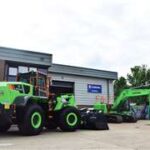What Is a Scissor Lift?
A scissor lift is a type of mobile work platform designed to elevate people and materials to hard-to-reach areas. Unlike boom lifts, which extend both horizontally and vertically, scissor lifts only move up and down using a crisscross mechanism—hence the name.
OSHA classifies scissor lifts as mobile-supported scaffold work platforms rather than aerial lifts. These machines are widely used across multiple industries for tasks like installing lighting, hanging signs, conducting maintenance, and even filming events.
How High Can a Scissor Lift Go?
Scissor lifts come in various heights, with the most common models reaching between 19 to 50 feet. The lifting capacity varies as well—compact models offer greater maneuverability, while heavy-duty models can handle up to 2,250 lbs.
Where Are Scissor Lifts Used?
Scissor lifts are used across industries requiring elevated access. Here are some key applications:
- Ceiling Work – Installing lighting, electrical wiring, and HVAC systems in commercial buildings.
- Sign Installation – Both indoor and outdoor signage placement.
- Power Line Repairs – Providing safe, stable elevation for maintenance.
- Warehouse Operations – Assisting with stock picking and inventory management.
- Film and Event Production – Offering unique camera angles and stage setup assistance.
- Outdoor Maintenance – Used for tree trimming, exterior painting, and façade repairs.
Types of Scissor Lifts
Scissor lifts come in different varieties depending on the job requirements. The two main categories include:
-
Electric Scissor Lifts
- Best for indoor use due to zero emissions and quiet operation.
- Ideal for warehouses, malls, and convention centers.
- Typically features non-marking tires for floor protection.
-
Rough Terrain Scissor Lifts
- Designed for outdoor use, featuring rugged tires and four-wheel drive.
- Built to handle slopes, dirt, and uneven terrain.
- Used in construction sites, bridges, and industrial maintenance.
Scissor Lift vs. Boom Lift
While both scissor lifts and boom lifts provide access to elevated work areas, they function differently:
| Feature | Scissor Lift | Boom Lift |
|---|---|---|
| Height | Up to 50 ft | Up to 210 ft |
| Movement | Vertical only | 360° rotation + horizontal reach |
| Load Capacity | Up to 2,250 lbs | Up to 500 lbs |
| Best For | Warehouses, indoor jobs, stable ground | Outdoor, reaching over obstacles |
Scissor Lift Safety: Key Tips
Scissor lifts are designed to be stable, but operators must follow essential safety guidelines:
- Always Check Guardrails – Ensure they are properly installed to prevent falls.
- Stabilize Before Operation – Place on firm, level ground and avoid using lifts in high winds.
- Stay Away from Power Lines – Keep a minimum distance of 10 feet from electrical hazards.
- Use Personal Protective Equipment (PPE) – Depending on job requirements, operators may need harnesses.
- Follow Manufacturer’s Load Limits – Overloading the platform can cause tipping.
By understanding the proper use, types, and safety measures associated with scissor lifts, you can ensure efficiency and security on any job site. Stay tuned for the next article, where we compare different types of scissor lifts!





